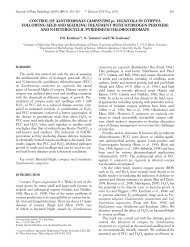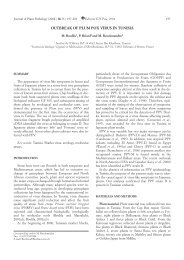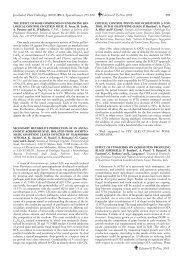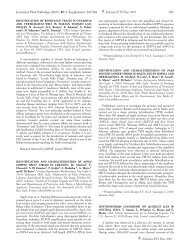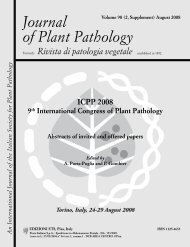Journal of Plant Pathology (2010), 92 (4, Supplement ... - Sipav.org
Journal of Plant Pathology (2010), 92 (4, Supplement ... - Sipav.org
Journal of Plant Pathology (2010), 92 (4, Supplement ... - Sipav.org
You also want an ePaper? Increase the reach of your titles
YUMPU automatically turns print PDFs into web optimized ePapers that Google loves.
<strong>Journal</strong> <strong>of</strong> <strong>Plant</strong> <strong>Pathology</strong> (<strong>2010</strong>), <strong>92</strong> (4, <strong>Supplement</strong>), S4.71-S4.105 S4.77<br />
Vitiello 108, 84018 Scafati (SA), Italy. E-mail: rosa.caiazzo@<br />
entecra.it<br />
Brassica oleracea L. var. acephala known as ‘torzella’ was in the<br />
past largely cultivated in southern Italy, then abandoned, and<br />
revaluated in recent years. In a farm in Scafati, where torzella was<br />
cropped for the first time, collar rot symptoms were observed on<br />
about 20% <strong>of</strong> the plants. Isolates <strong>of</strong> Rhizoctonia solani Kühn,<br />
showing the typical hyphal branching and multinucleate cells,<br />
were recovered from affected tissues. Determination <strong>of</strong> anastomosis<br />
groups was carried out by pairing isolates with tester strains on<br />
2% water agar (WA) in Petri plates. Hyphal anastomosis was only<br />
observed with tester isolates <strong>of</strong> AG-4, producing both C2 and C3<br />
reactions. Moreover, typical AG-4 isozyme patterns were obtained<br />
after polygalacturonase gel electrophoresis. The clonal condition<br />
<strong>of</strong> the isolates was also assessed by examining tuft formation in<br />
pairings on PDA supplemented with 0.5% activated charcoal. Finally,<br />
a biomolecular analysis was carried out by means <strong>of</strong> RFLPs<br />
<strong>of</strong> rDNA-ITS by using HincII and HpaI as restriction enzymes to<br />
assign torzella isolates to one <strong>of</strong> the three homogeneous groups<br />
(HG-I, -II and -III) so far characterized within R. solani AG-4.<br />
Pathogenicity test confirmed the ability <strong>of</strong> R. solani AG-4 isolates<br />
to induce collar rot. These isolates were recovered from symptomatic<br />
tissues, thus fulfilling Koch’s postulates.<br />
TRANS-RESVERATROL AND LEAF SYMPTOM EXPRES-<br />
SION IN ESCA OF GRAPEVINE. F. Calzarano 1 , V. D’Agostino<br />
1 , F. Osti 2 , S. Di Marco 2 . 1 Dipartimento di Scienze degli Alimenti,<br />
Università degli Studi, Via C.R. Lerici 1, 64023 Mosciano<br />
Sant’Angelo (TE), Italy. 2 Istituto di Biometeorologia del CNR, Via<br />
P. Gobetti 101, 40129 Bologna, Italy. E-mail: fcalzarano@unite.it<br />
Esca <strong>of</strong> grapevine is a serious disease some aspects <strong>of</strong> which,<br />
including the nature <strong>of</strong> foliar symptoms, are still poorly understood.<br />
Leaves collected at different phenological growth stages<br />
from symptomatic grapevines cv. Trebbiano d’Abruzzo showed<br />
the presence <strong>of</strong> higher concentrations <strong>of</strong> trans-resveratrol, the<br />
major stilbene produced in grapevine, compared to leaves from<br />
healthy plants. Increased levels <strong>of</strong> trans-resveratrol are supposed<br />
to be associated with the host-plant defence response, but this<br />
condition raises questions on the possible role <strong>of</strong> the stilbene in<br />
the foliar symptom development. Symptomatic leaves collected in<br />
2009 were divided into 4 classes estimating symptom severity as<br />
the percentage <strong>of</strong> chlorosis and necrosis on the total leaf area. For<br />
each class, leaves were collected at pre-bunch closure, post-veraison<br />
and harvest, and the level <strong>of</strong> trans-resveratrol was determined.<br />
The results showed higher concentrations <strong>of</strong> trans-resveratrol<br />
in symptomatic leaves collected at pre-bunch closure compared<br />
to what observed at the other growth stages. These results<br />
are in agreement with our previous findings, i.e. the stronger response<br />
<strong>of</strong> the leaves might be correlated with leaf functioning at<br />
the different phenological growth stages. Moreover, the increase<br />
<strong>of</strong> trans-resveratrol concentration with increased severity <strong>of</strong> leaf<br />
symptoms seems to exclude an involvement <strong>of</strong> the stilbene in<br />
symptom development. Further investigations on cut leaves inoculated<br />
with culture filtrates <strong>of</strong> the pathogen and/or trans-resveratrol<br />
may lead to a better understanding <strong>of</strong> the relationship between<br />
the stilbene and foliar symptom expression.<br />
THREE BASIDIOMYCETES CONTAMINATING COM-<br />
POST FOR CULTIVATION OF PLEUROTUS ERYNGII. I.<br />
Camele, L. Altieri, G.L. Rana. Dipartimento di Biologia, Difesa e<br />
Biotecnologie Agro-Forestali, Università degli Studi della Basilica-<br />
ta, Via Ateneo Lucano 10, 85100, Potenza, Italy. E-mail:<br />
ippolito.camele@unibas.it<br />
The basidiomycetes Oxyporus latemarginatus, Schizophyllum<br />
commune and Bjerkandera adusta were found contaminating substrate<br />
commonly used to grow Pleurotus eryngii in southern Italy<br />
in 2009. More specifically, basidiomes <strong>of</strong> O. latemarginatus and S.<br />
commune appeared on the compost surface at beginning <strong>of</strong> a cultivation<br />
in Sardinia and in an incubation tunnel <strong>of</strong> ITALMIKO<br />
agricultural farm in Basilicata, respectively. B. adusta formed<br />
sporophores after the first production flush in a P. eryngii autumnal<br />
culture in Apulia. Identification <strong>of</strong> the three contaminants<br />
was at first achieved on the basis <strong>of</strong> their macro- and microscopic<br />
features. Molecular analysis, done by PCR and nucleotide sequencing,<br />
confirmed the identity <strong>of</strong> the first and second contaminant<br />
as O. latemarginatus and B. adusta. DNA was extracted from<br />
pure cultures <strong>of</strong> both contaminants and amplified with primers<br />
ITS4/ITS5. Nucleotide sequences <strong>of</strong> O. latemarginatus (isolates<br />
n. 947) and B. adusta (isolate n. 1147) were 606 and 609 bp in<br />
size and showed a 99% similarity with GenBank sequences <strong>of</strong> the<br />
two fungi (accession numbers AF 232721 and AJ 006672). Two<br />
nucleotide sequences <strong>of</strong> the above isolates <strong>of</strong> O. latemarginatus<br />
and B. adusta were deposited at the European Molecular Biology<br />
Laboratory (UK) with access codes FN 252852 and FN995241,<br />
respectively. This is the first report <strong>of</strong> O. latemarginatus and S.<br />
commune as contaminants and competitors <strong>of</strong> P. eryngii in exploiting<br />
cultivation compost. By contrast, B. adusta was already<br />
known as contaminant <strong>of</strong> the same substrate.<br />
EFFECT OF ORGANIC AMENDMENTS AND MICRO-<br />
BIAL DIVERSITY ON SOIL FUNGISTASIS. M. Capodilupo,<br />
G. Bonanomi, M. Ceniccola, V. Antignani, F. Scala. Dipartimento<br />
di Arboricoltura, Botanica e Patologia Vegetale, Università degli<br />
Studi di Napoli “Federico II”, Via Università 100, 80055 Portici<br />
(NA), Italy. E-mail: felice.scala@unina.it<br />
Soil fungistasis is defined as the inhibition <strong>of</strong> fungal propagule<br />
germination under favourable conditions. In this study, we analyzed<br />
the effect on fungistasis <strong>of</strong> four different carbon sources<br />
(glucose, starch, PDB and Medicago sativa hay) at different times<br />
<strong>of</strong> decomposition (0, 2, 4, 7, 28 and 46 days) applied at three concentration<br />
levels (3%, 0.3% and 0.03%). Fungistasis was assessed<br />
by germination tests carried out with four fungi: Aspergillus<br />
flavus, Botrytis cinerea, Mucor sp. and Trichoderma<br />
harzianum. Microcosms were characterized for pH, electrical<br />
conductivity and fluoresceine diacetate hydrolytic activity (FDA).<br />
We also tested the influence <strong>of</strong> microbial diversity on fungistasis.<br />
Microbial consortia with three levels <strong>of</strong> diversity (1, 3 and 9<br />
species) were assembled from a pool <strong>of</strong> known micro<strong>org</strong>anisms<br />
selected among different functional groups. In this case, fungistasis<br />
was assessed by using Rhizoctonia solani as a target fungus. We<br />
found that fungistasis was rapidly lost after the application <strong>of</strong> all<br />
<strong>org</strong>anic amendments but it was also restored, usually within 7-28<br />
days, according to the type and the amount <strong>of</strong> amendment. Mucor<br />
sp. was the most sensitive fungus while A. flavus was the less<br />
affected. Fungistasis towards R. solani was enhanced and much<br />
less variable in the presence <strong>of</strong> microcosms <strong>of</strong> increasing microbial<br />
diversity. We conclude that soil fungistasis is strictly dependent<br />
on decomposition <strong>of</strong> <strong>org</strong>anic matter and diversity <strong>of</strong> the microbial<br />
communities.<br />
OCCURRENCE OF LECANICILLIUM MUSCARIUM AS<br />
AN ANTAGONIST OF SOIL-BORNE FUNGAL



